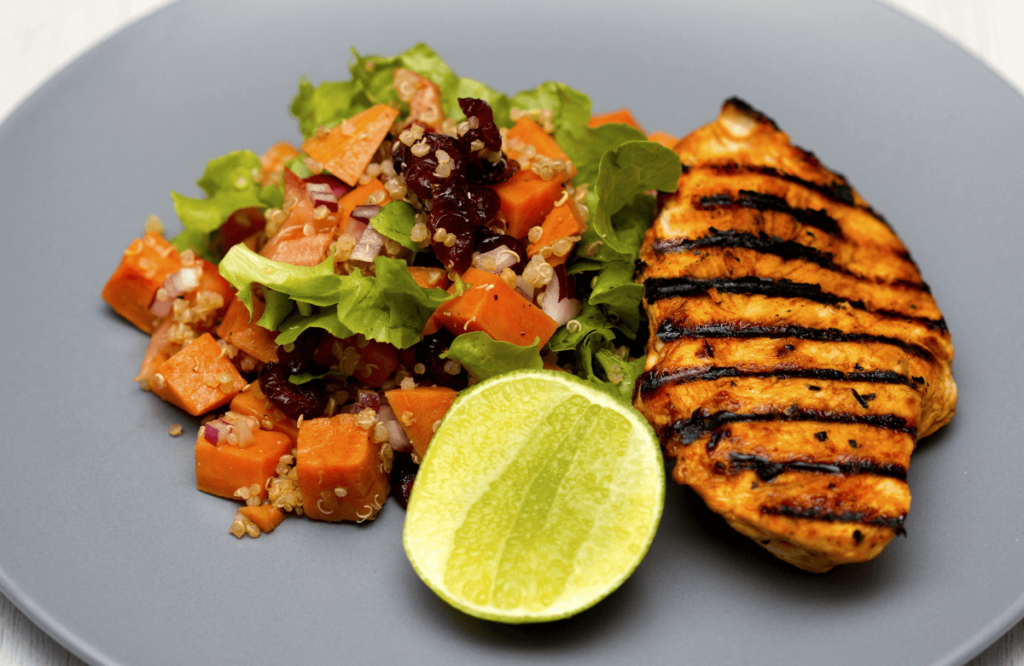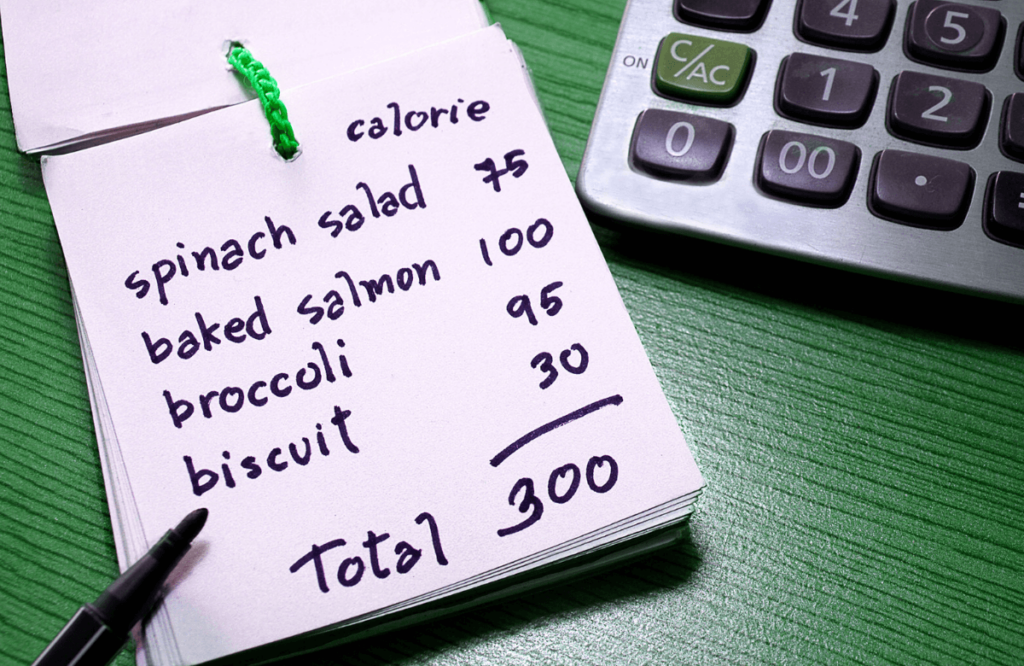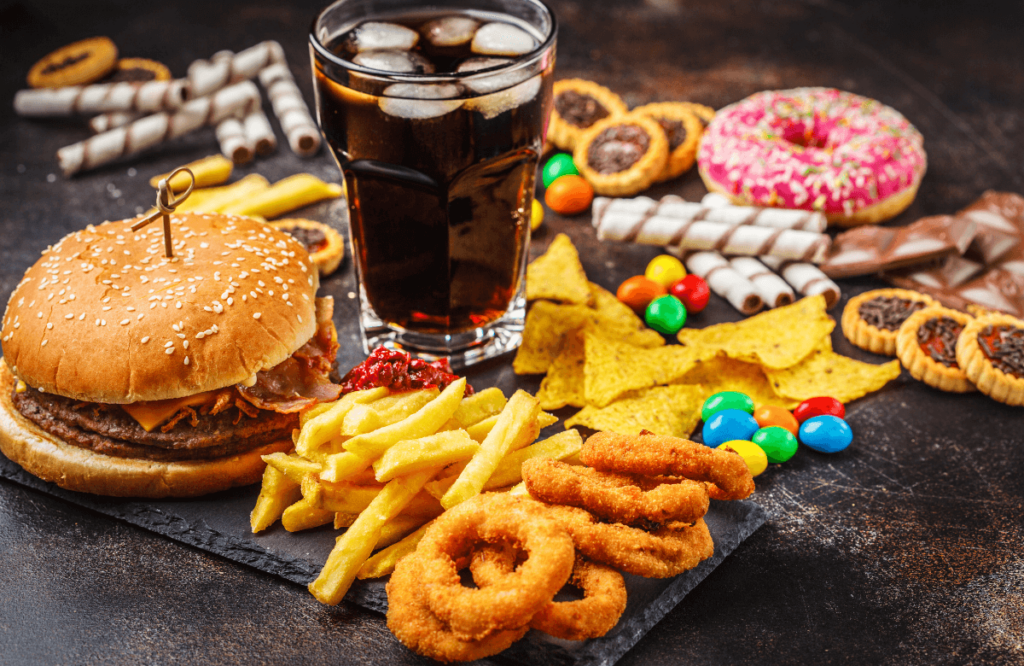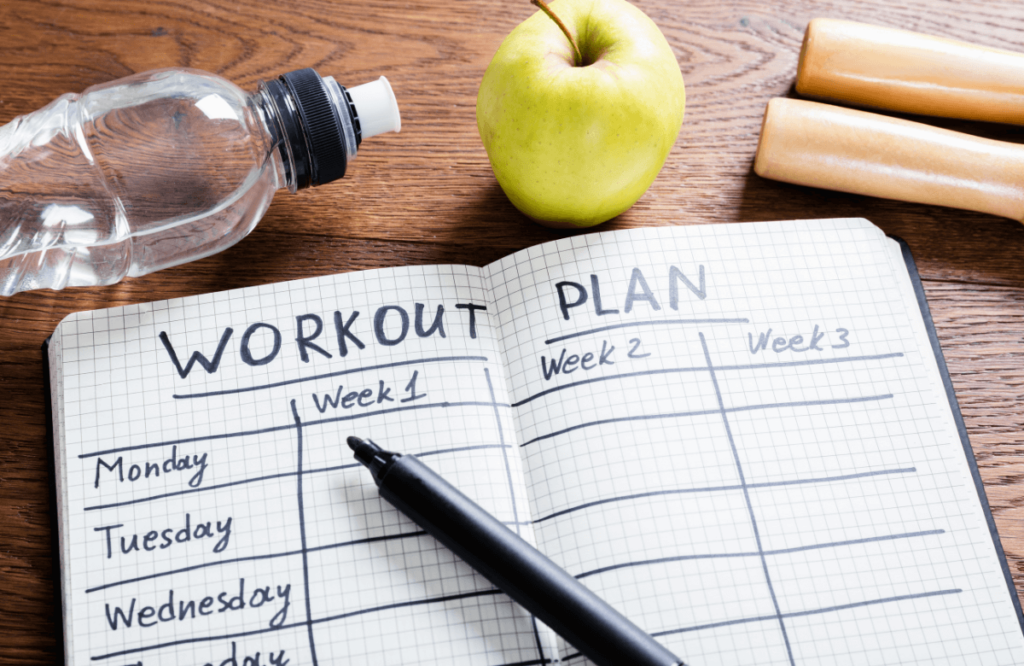We’ve all heard the saying, “You have to eat big to get big.” Many beginner lifters take this saying to mean eating cheeseburgers, french fries, and milkshakes. This method is known as dirty bulking and isn’t ideal for muscle gain.
That’s where a lean bulk comes into play.
An effective lean bulking strategy can ensure you gain muscle mass while minimizing excess fat gain. There’s a lot to learn and consider before diving in. Fortunately, we cover everything you need to know on how to lean bulk in the article below.
Jump to:
What Is a Lean Bulk?
Bulking refers to a period of intentional weight gain to build muscle mass and increase overall body size.
A lean bulk is a specific approach to building muscle and gaining weight while minimizing fat gain. It involves consuming a slight caloric surplus to support muscle growth while adhering to a balanced and nutritious diet.
- Focus on consuming a balanced diet that includes adequate protein, carbohydrates, and healthy fats.
- Emphasize whole, unprocessed foods that are rich in nutrients.
- Lean protein sources, fruits, vegetables, whole grains, and healthy fats should be included in your diet.
- Engage in a structured weightlifting or resistance training program to stimulate muscle growth.
The objective of lean bulking is to strike a balance between gaining weight and building muscle without excessive fat accumulation.

What Is a Dirty Bulk?
Dirty bulking is an approach to weight gain involving consuming a large calorie surplus without much regard for the quality of the food.
The primary focus is on consuming a high number of calories, often through processed and calorie-dense foods, intending to maximize muscle growth without much consideration for potential fat gain.
- Focus on consuming as many calories as possible, potentially gaining more fat.
- A less disciplined approach with fewer restrictions.
- Typically includes junk food, sugary snacks, high-calorie drinks, saturated fats, processed ingredients, and sugars.
- Poor food choices may lack essential nutrients, affecting health, strength gains, and recovery.
- Transitioning from a dirty bulk to a cutting phase can be challenging due to the significant amount of accumulated fat and poor habits.
The rationale behind a dirty bulk is that by consuming a substantial surplus of calories, individuals provide their bodies with an abundance of energy and nutrients needed for muscle growth. However, this approach can lead to excessive fat gain, potentially compromising overall health and body composition.
What Are the Benefits of Lean Bulking?
Clean bulking provides several benefits for strength training and muscle gains. Muscle building is the primary goal but without excess body fat gains or a cost to health. Here are some key advantages.
Controlled Fat Gain
Clean bulking aims to minimize fat gain while focusing on muscle growth. By adopting a more conservative calorie surplus, individuals can limit excess fat gain and maintain a leaner physique throughout the bulking phase.
Improved Body Composition
With a clean bulk, the goal is to increase muscle mass and keep body fat levels in check.
This approach helps to enhance overall body composition by promoting a higher muscle-to-fat ratio, resulting in a more defined and athletic appearance.

Balanced Nutrient Intake
Lean bulking prioritizes a balanced diet with adequate amounts of protein, carbohydrates, and healthy fats. Nutritious foods provide your body with enough resources to support muscle growth, recovery, and overall health.
A nutritious bulking diet will also give you the energy you need to maintain workout performance throughout the cycle. Healthy, organic, and unprocessed foods can lower the risk of diabetes, high blood pressure, and other health issues.
Sustainable Progress
Lean bulking requires you to calculate your daily energy expenditure, caloric intake, and ideal macros.
Not only will this provide you with ample energy levels to maintain high athletic performance, but it’s easier to track your progress. Through mobile apps, consistent weigh-ins, and meal plans, you can stay on target to hit your goals.
Clean bulking also makes it easier to avoid excessive weight gain and fat accumulation, allowing you to maintain a healthier and more manageable rate of muscle growth over time.
Psychological Benefits
There are multiple psychological benefits to eating healthy. More research needs to be conducted, but we’re finding that mental health is strongly correlated to what you eat.
One study showed that adults adhering to healthy diet patterns have fewer depressive symptoms and a lower risk of developing depressive symptoms.
Another study found that following the MIND diet was significantly associated with a lower chance of depression and psychological distress. Other studies have found eating more fruits and vegetables correlates to lower odds of worries, tension, and low levels of joy.
Regardless of the research, it makes sense that eating less junk food will make you feel better. The more nutrients you consume, the more resources your brain and body have to function correctly.
A lean bulking diet of nutritious, organic, and whole foods is sure to impact your well-being inside and outside of the gym.

How Do You Start a Lean Bulk?
So, now that you understand the benefits and you’re on board with a clean bulking diet, how do you get started?
The foundation of any effective nutritious bulking diet is calculating your extra calories per day and macronutrients.
The other steps are setting realistic goals and timeframes, creating a workout plan, and developing strategies to mitigate common pitfalls.
How Long Does a Lean Bulk Last?
The duration of a lean bulk can vary depending on individual goals, starting points, and progress. Generally, a lean bulk typically is a long-term approach, lasting between 3–12 months, depending on these factors.
On average, most individuals can gain 0.5–2 pounds of muscle per month.
The rate of muscle growth depends on several factors, like genetics, training history, diet, recovery, and the strength training regimen. Beginners may gain more muscle mass, with the potential for 1 pound per week or 4 pounds per month.
How to Calculate Your Daily Calorie Surplus
The first step to starting a lean bulk is to calculate your daily calorie intake.
Lean muscle gain requires extra calories, so you will need to determine your maintenance calories and add a slight surplus.
Calculating Your Total Daily Energy Expenditure (TDEE)
Your total daily energy expenditure (TDEE) is the number of calories your body burns throughout the day, commonly called maintenance calories.
Your TDEE is impacted by several factors, like height, weight, age, gender, and activity levels.
There are several formulas used to calculate TDEE, but the most accessible method is to use an online calculator. Simply provide your age, gender, height, weight, and activity levels to see how many calories you need per day.
These calculators may not be 100% accurate, but they will provide you with a good starting point for how many calories you need to gain muscle mass.

Calculating Caloric Surplus
So, now that you know how many calories you burn each day, how do you determine your daily calorie surplus?
Healthy adults can gain roughly 0.5–1 pounds per week or 2–4 pounds of weight per month without much issue.
That said, your rate of weight gain will depend on your fitness goals, timeframe, diet plan, and training schedule. Many individuals recommend a conservative calorie surplus of 300-500 calories, or 10–15% more than your maintenance calories.
Calculating Macronutrients
Besides managing your calorie intake, it’s essential to determine how many grams of protein, fat, and carbs you need per day. These essential macronutrients are critical for managing muscle gains while minimizing fat gain.
- The body requires adequate protein intake for muscle protein synthesis, or the process by which muscles grow and repair.
- Carb intake is vital for managing energy levels, so you can maintain a high workout performance.
- Fat macros also help you store energy, absorb nutrients, and play a vital role in overall bodily function.
Here’s a simple breakdown of how to calculate your macros:
- Protein: One gram of protein is 4 calories. It’s recommended to consume 1–1.5 grams of protein per pound of body weight per day. This may account for 20–30% of your daily calories.
- Fat: One gram of fat is 9 calories. It’s recommended to consume around 0.3 grams of fat per pound of body weight. This may translate to 20-30% of your total daily caloric intake.
- Carbs: One gram of carbohydrates is 4 calories. The rest of your daily calorie intake should be from carbohydrates or roughly 40–60% of your total daily calories. This will provide you with enough energy to hit the gym and perform throughout the day.
The most accessible way to determine your ideal macros is to use a Macronutrient Calculator.
Remember, your bulk meal plan will vary depending on your weight, fitness levels, diet restrictions, and goals. You may opt for a high-protein diet, lower carbohydrates, or low-fat levels.

Creating a Meal Plan
Now that you understand how many calories you need per day and the amount of fats, protein, and carbs, it’s time to create a meal plan.
A nutritious bulking diet will be mainly composed of whole and minimally processed options, but this doesn’t mean you can’t include “cheat” items.
Creating an effective meal plan will include the times you eat, the number of meals, and potential items to include or avoid.
Determine When You Will Eat and the Number of Meals
Before you fill your shopping cart with leafy greens, lean meats, and whole-grain bread, you will need to decide when you will eat and the number of meals. A bulking diet—especially a lean bulk—requires discipline and structure for success.
Knowing when you will eat and how many times you will eat in a day will also help you determine how many calories each plate should be. An example schedule might look like the following:
- Breakfast: 7:00 am
- Snack: 9:00 am
- Lunch: 12:00 pm
- Snack: 3:00 pm
- Dinner: 6:00 pm
This will vary depending on your lifestyle, circumstances, and preferences. You may prefer eating multiple, smaller meals throughout the day. Or, you might have a work schedule where it’s more realistic to have three large meals in a single day.
You don’t have to stick to the schedule as if your life depends on it, and you can adjust it if things change. It’s only to provide you with more structure so you can hit your goals more easily.

Healthy Food Choices
Clean bulking includes whole, minimally processed, and nutritious food choices. Your meal plan will vary depending on several factors, like preferences, diet restrictions, and the availability of items.
Remember that foods can be high in several macronutrients. For example, salmon is a fantastic source of protein and healthy fats.
Here are a few food choices to keep in mind when you’re shopping for your bulking diet.
Lean Bulking Proteins
- Sirloin steak
- Ground beef
- Pork tenderloin
- Chicken breast
- Venison
- Salmon
- Tilapia
- Cod
- Egg whites
- Chickpeas
- Greek yogurt or Skyr
- Cottage cheese
- Low-fat milk
Lean Bulking Carbs
- Quinoa
- White or brown rice
- Sweet potatoes
- Whole grain pasta
- Ezekiel bread
- Potatoes
- Oats
- Granola
- Bananas, oranges, apples, berries, and other fruits
- Broccoli, spinach, mushrooms, asparagus, and other vegetables
Lean Bulking Fats
- Avocados
- Whole eggs
- Olive oil
- Almonds, peanuts, walnuts, cashews, and other nuts and seeds
- Nut butter
- Coconut oil

Foods to Avoid
There are certain foods you should avoid or limit during a lean bulking cycle. Some of these options are okay in moderation, but your consumption will dampen your preferences, goals, and lifestyle.
- Alcohol: Alcohol can negatively impact your ability to build muscle and lose fat, especially when consumed in high quantities.
- Added sugars: Sugary beverages, candy, ice cream, and other desserts are high in calories but offer few nutrients. It’s better to look for healthier, nutrient-dense substitutes instead.
- Deep-fried foods: These options can contribute to inflammation and health complications when consumed in high quantities. It’s best to avoid foods like fried meats, french fries, and onion rings.
- Overly processed foods: Highly-processed foods can contain high amounts of added sugar, sodium, and fat. This can lead to health complications when consumed in excess and destroy your macronutrients for the day.
Basically, minimize the amount of junk food you consume. A doughnut or order of french fries here and there won’t destroy your diet, but consuming too much can lead to adverse health complications and negatively impact your progress.
How to Train During a Lean Bulk
There are countless workout programs you can use to build muscle, like PPL, upper/lower, and bodybuilding splits. Each of these routines has advantages, disadvantages, and best-use cases.
However, there are a few principles you can stick to regardless of the training program.
Resistance Training
It’s best to follow a structured resistance training program that targets all the major muscle groups. Compound exercises, like squats, deadlifts, bench presses, overhead presses, and rows, are necessary, as they involve multiple muscle groups and stimulate overall muscle growth.
It can also be wise to use both free weights and machines when appropriate. This will provide more variety and engage your muscles in different ways.
Incorporate Progressive Overload
Progressive overload is crucial for stimulating muscle growth and adaptation. Progressive overload is continuously challenging the muscles by increasing the intensity, volume, or resistance of your workouts over time.
This can be achieved by adding weight to your lifts, increasing the number of sets or reps, or reducing rest periods.
For example, you might add 5–10 pounds to your bench press each time you perform the exercise. Or, you may add 5–10 pounds to your squat each week. The exact details will depend on your training regimen.

Adjust the Rep Range
For most exercises, a moderate rep range of around 8–12 reps per set is ideal. This range is often regarded as optimal for muscle hypertrophy.
That said, incorporating higher weights in ranges around 4–6 reps can be beneficial for strength gains. This rep range is typically recommended for compound lifts, like the squat or bench press.
Higher rep ranges around 12–15 reps can be great for building muscle endurance and isolation exercises. The exact rep range will depend on your training protocol, fitness goals, and activity.
Get Enough Volume Each Week
It’s crucial to get enough volume of training for each muscle group to stimulate muscle growth. This can look like performing 3–4 sets per exercise and targeting each muscle group at least twice a week.
You’ll need to find a training frequency and volume that suits your lifestyle and recovery time.
For example, you may follow a three-day week training schedule but lift heavier weights. Or, you may use a lower weight for more repetitions. It all depends on your fitness goals, preferences, and training schedule.
Rest and Recovery
Your muscles need enough time to recover and repair between training days. Incorporate dedicated rest days into your regimen and prioritize high-quality sleep.
Doing so will support muscle repair and growth. Avoid overtraining, as it can hinder your progress.
Always listen to your body and adjust your training as needed.
Don’t Forget Cardio
While the main focus is on muscle growth, including cardiovascular exercise can contribute to overall health and help manage fat gain during a lean bulk.
Incorporate regular aerobic activities, such as jogging, cycling, or swimming, into your routine. Aim for 2-3 moderate-intensity cardio sessions per week or adjust based on your goals and recovery capacity.

Tips For a Successful Bulk
There’s a lot to consider when attempting an effective lean bulk. Calculating calories and macronutrients, hitting the gym, avoiding junk food, and getting enough rest can quickly become a challenge.
But there’s no need to give up hope or be hard on yourself. With a plan and a consistent work ethic, you can master the techniques and achieve results. Here are some tips to keep in mind to make your lean bulk easier.
Set Clear and Realistic Goals
Clarity and realistic expectations are necessary for any goal, including building muscle mass.
Clearly defining your goals will provide you with a clear idea of your desired result. Your goal may be to put on 10 pounds of lean muscle mass or increase your compound lifts by 100 pounds.
Either way, a clear objective will help you develop an effective strategy to get there and keep you focused and motivated.
But it’s important to have realistic expectations. It’s implausible for someone to build 10 pounds of muscle in a month—it might even be impossible. Instead, set realistic expectations and timeframes that include enough room for mistakes.
Doing so will allow you to achieve your results and make consistent progress without becoming discouraged.
Monitor Your Progress
Imagine you’re trying to drive across the country without a map. You may be moving forward, and you may eventually reach your destination, but how can you know if you’re on track?
Bulking without tracking your progress and efforts is much the same—you won’t know if you’re on pace to hit your target.
Instead, regularly track your body weight, measurements, and strength gains to gauge your progress.
This can be in the form of a notebook, mobile app, excel sheet, or similar method. It’s essential to see what’s working and what isn’t so you can adjust your training regimen accordingly.
Create Fail-Safes
What are you going to do if things don’t go according to plan? Do you have strategies in place to help you achieve your goals?
It’s essential to create fail-safes for any goal, but especially something as labor-intensive as lean bulking. Some examples might include:
- Planning meals and preparing them ahead of time to ensure you have nutritious options readily available.
- Using a food-tracking app or journal to monitor your daily caloric intake and macronutrient distribution.
- Setting alarms or reminders on your phone to hit the gym, eat, and rest.
- Find an inga training partner or join a community of like-minded individuals pursuing fitness.
The type of fail-safe will vary depending on your goals and lifestyle. The goal is to create a system that keeps you accountable and mitigates setbacks.
But remember to celebrate your progress, stay committed to your goals, and don’t be too hard on yourself if you encounter occasional setbacks. Keep the big picture in mind and enjoy the journey towards building a leaner and more muscular physique.

Frequently Asked Questions (FAQ)
What Is the Best Way to Lean Bulk?
There isn’t a one-size fits all answer to lean bulking. That said, it’s essential to eat a caloric surplus of nutritious foods with adequate protein intake. You can use calorie and macronutrient calculators to determine your daily intake. Progressive overload can also help you challenge your muscles and gain strength.
Is Lean Bulking Worth It?
Yes, lean bulking is worth it. Lean bulking is preferred over dirty bulking, as it offers more nutrient-dense foods. This ensures your body gets enough vitamins and minerals to build and repair muscles.
Will I Gain Fat on a Lean Bulk?
A bit of fat gain is likely, even on a lean bulk. You have to eat more calories than you burn to gain muscle mass, leading to a bit of fat. Calculating your calories and macronutrients will ensure you’re minimizing the amount of fat gain during the bulking cycle.














